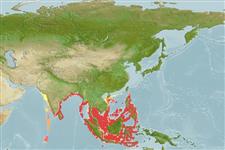>
Eupercaria/misc (Various families in series Eupercaria) >
Nemipteridae (Threadfin breams, Whiptail breams)
Etymology: Nemipterus: Greek, nema, -atos = filament + Greek, pteron = wing, fin (Ref. 45335).
More on author: Bleeker.
Environment: milieu / climate zone / Tiefenbereich / distribution range
Ökologie
seewasser demersal; standorttreu; tiefenbereich 30 - 100 m (Ref. 28016). Tropical; 22°N - 11°S, 68°E - 127°E
Indo-West Pacific: Gulf of Thailand to southern Indonesia. This species has been confused with Nemipterus marginatus.
Length at first maturity / Size / Gewicht / Alter
Geschlechtsreife: Lm 10.3 range ? - ? cm
Max length : 14.0 cm SL Männchen/unbestimmt; (Ref. 3810); common length : 13.0 cm SL Männchen/unbestimmt; (Ref. 3810)
Rückenflossenstacheln (insgesamt) : 10; Rückenflossenweichstrahlen (insgesamt) : 9; Afterflossenstacheln: 3; Afterflossenweichstrahlen: 7. Lower edge of eye lies below a line drawn from tip of snout to upper base of pectoral fin. Lower edge of suborbital very slightly emarginate; the posterior edge more or less straight. Dorsal fin origin about 4-7 scale rows from an imaginary line projected upwards from posterior edge of suborbital to dorsal profile. Axillary scale present. Color: Oblique golden yellow stripe from beneath eye to middle of maxilla. Upper body pinkish, silvery white below. This species closely resembles N. marginatus, but lacks the filamentous extension to the upper lobe of the caudal fin; the posterior margin of the suborbital is more or less straight, rather than evenly curved; and the upper stripe on the body is not divided anteriorly.
Body shape (shape guide): fusiform / normal; Cross section: oval.
Little is known about the habits of this species. Minimum depth from Ref. 9773.
Russell, B.C., 1991. Description of a new species of Nemipterus (Pisces: Perciformes; Nemipteridae) from the Western Pacific, with re-descriptions of Nemipterus marginatus (Valenciennes), N. mesoprion (Bleeker) and N. nematopus (Bleeker). J. Nat. Hist. 25:1379-1389. (Ref. 3207)
IUCN Rote Liste Status (Ref. 130435: Version 2025-1)
Bedrohung für Menschen
Harmless
Nutzung durch Menschen
Fischereien: weniger kommerziell
Tools
Zusatzinformationen
Download XML
Internet Quellen
Estimates based on models
Preferred temperature (Ref.
123201): 23.7 - 28.3, mean 27.3 °C (based on 137 cells).
Phylogenetic diversity index (Ref.
82804): PD
50 = 0.5000 [Uniqueness, from 0.5 = low to 2.0 = high].
Bayesian length-weight: a=0.01288 (0.01094 - 0.01518), b=2.96 (2.93 - 2.99), in cm total length, based on LWR estimates for this species (Ref.
93245).
Trophic level (Ref.
69278): 3.7 ±0.5 se; based on size and trophs of closest relatives
Widerstandsfähigkeit (Ref.
120179): hoch, Verdopplung der Population dauert weniger als 15 Monate. (K=0.8; tm=0.7; Fec=1,213).
Fishing Vulnerability (Ref.
59153): Low vulnerability (10 of 100).
🛈
